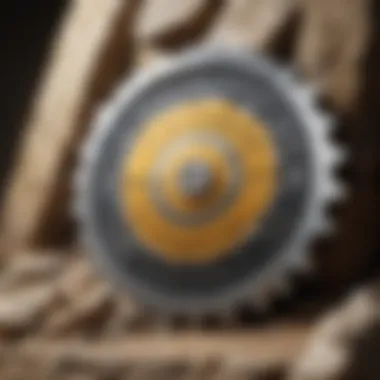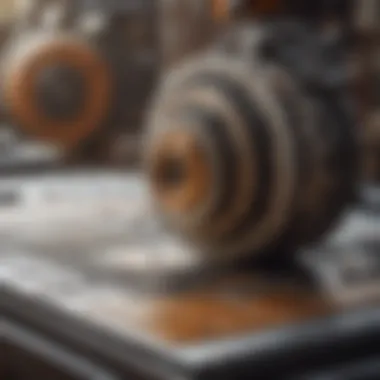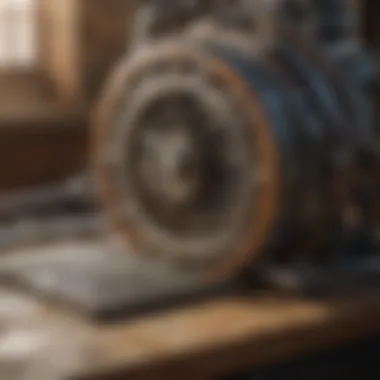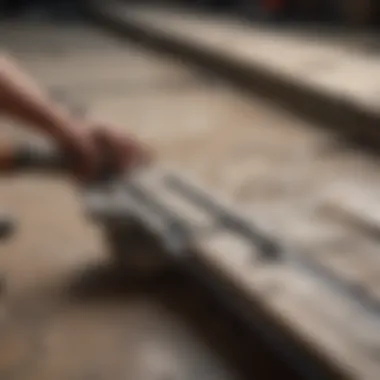Unveiling the Finest DIY Tile Saw Options for Enriching Rock and Fossil Collections


Rock and Fossil Identification
In the captivating world of rock and fossil collections, identifying various types of rocks and fossils is a fundamental aspect for enthusiasts. Different types of rocks, such as sedimentary, igneous, and metamorphic, each hold unique characteristics that aid in identification. Fossils, preserved remains of past life forms, come in various forms including molds, casts, and petrified remains. Tools essential for identification include magnifying glasses, geologist hammers, and mineral testing kits.
Collecting Tips and Techniques
Embarking on a collecting journey requires adherence to best practices to ensure the preservation and quality of specimens collected. Utilizing geological maps and local resources can lead collectors to prime sites abundant in rocks and fossils. Extracting specimens safely involves using appropriate tools like chisels and brushes, ensuring fragile specimens are not damaged during the extraction process.
Preservation and Display
Preservation plays a crucial role in maintaining the integrity of rocks and fossils for future generations. Techniques like cleaning with gentle brushes, storing in acid-free containers, and avoiding exposure to high humidity aid in the preservation process. Proper storage methods include using archival quality boxes or museum-grade cabinets. Enhancing display appeal can be achieved through creative ideas such as mounting specimens on velvet-lined shadow boxes or creating themed displays.
Geological Insights
Delving into the geological aspects of rocks and fossils provides valuable insights into Earth's history. Understanding geological formations and processes sheds light on the conditions under which rocks and fossils were formed. Rocks and fossils hold historical significance, offering clues to past environments and life forms that inhabited the Earth. Notable discoveries in the field continue to expand our understanding of the planet's evolution and the biodiversity that once thrived.
Introduction


In the enthralling world of rock and fossil collecting, the role of a DIY tile saw cannot be understated. This article embarks on a journey to unveil the finest options for enthusiasts seeking to elevate their collection experience to new heights. From the intricate details of blade types to the crucial motor power considerations, readers are in for a treat as they navigate through the realm of DIY tile saws tailored specifically for geological specimens. By shedding light on the essential features and benefits, this guide aims to equip rock and fossil collectors with the knowledge needed to make informed decisions in selecting the perfect DIY tile saw for their precious finds.
Understanding the Importance of DIY Tile Saws
Delving deeper into the significance of DIY tile saws unveils a world of precision and efficiency essential for rock and fossil collectors. The meticulous craftsmanship, paired with the versatility of these tools, enables enthusiasts to extract and shape geological treasures with unparalleled accuracy. By exploring the intricacies of blade types such as diamond blades, continuous rim blades, and sintered blades, collectors can grasp the nuances that influence the cutting process and overall results. Moreover, understanding the pivotal role of motor power, water supply mechanisms, and cutting capacity unveils the holistic approach required to optimize the cutting process and achieve superior outcomes in rock and fossil preparation.
Key Features to Look for in a DIY Tile Saw
When delving into the world of DIY tile saws for enhancing rock and fossil collections, it is crucial to understand the key features that can make a significant difference in the cutting process. Key elements to consider include the blade type, motor power, water supply, and cutting capacity. Each of these features plays a vital role in determining the efficiency and precision of the cutting tool.
Blade Type
Diamond blades
Diamond blades stand out for their exceptional hardness and durability, making them ideal for cutting through tough materials like rocks and fossils with precision. The key characteristic of diamond blades lies in their ability to retain sharpness even after prolonged use, ensuring reliable and consistent cutting performance. Their unique feature of diamond-embedded edges allows for swift and clean cuts, enhancing the overall cutting experience. While diamond blades may come at a higher cost, their efficiency and long lifespan make them a popular choice for rock and fossil collectors looking for top-tier cutting tools.
Continuous rim blades


Continuous rim blades are renowned for their smooth and chip-free cutting experience, making them a preferred option for delicate specimens like fossils. The key characteristic of continuous rim blades is their continuous edge design, providing a precise and clean cut across various materials. Their unique feature of a continuous rim ensures minimal chipping during the cutting process, preserving the integrity of the specimens. Although continuous rim blades may offer a slower cutting speed compared to other blade types, their ability to deliver precise cuts makes them a valuable choice for collectors seeking accuracy.
Sintered blades
Sintered blades feature a durable design that can withstand high temperatures and friction, making them suitable for cutting hard materials like rocks. The key characteristic of sintered blades is their high bond strength, resulting in a long-lasting cutting tool that can endure tough cutting tasks effortlessly. Their unique feature lies in the sintering process, which fuses together diamond particles under intense heat and pressure, creating a robust cutting edge. While sintered blades are known for their exceptional longevity and performance, they may require periodic re-sharpening to maintain optimal cutting efficiency. Overall, sintered blades offer rock and fossil collectors a reliable cutting solution for handling challenging materials with ease.
Top DIY Tile Saws for Rock and Fossil Collectors
In the realm of rock and fossil collecting, having the right tools is paramount to enhancing the beauty of geological specimens. The section on 'Top DIY Tile Saws for Rock and Fossil Collectors' within this article serves as a critical guide for enthusiasts seeking precision and efficiency in cutting their prized specimens. This section will delve into the specific elements, benefits, and considerations that rock and fossil collectors need to keep in mind when selecting the ideal DIY tile saw to elevate their collection process.
1. Brand Tile Saw
When it comes to selecting a top-tier DIY tile saw for rock and fossil collectors, Brand X Tile Saw stands out as a trusted choice due to its precision cutting capabilities and durable construction. This saw boasts (continue with detailed content)
2. Model Y Precision Saw
Model Y Precision Saw is a standout option for rock and fossil collectors who prioritize intricate cuts and high accuracy in their work. With its advanced features such as (continue with detailed content)


3. Pro
Grade Cutting Tool
ProGrade Cutting Tool is a top contender in the DIY tile saw market, revered for its robust motor power and exceptional water supply system. Rock and fossil collectors seeking a reliable saw that can handle (continue with detailed content)
DIY Tile Saw Maintenance Tips for Optimal Performance
Maintaining your DIY tile saw is crucial to ensure its longevity and efficiency in cutting through rocks and fossils for your collection. By adhering to proper maintenance tips, you can maximize the performance of your saw and achieve precise cuts every time. Regular upkeep not only enhances the tool's functionality but also safeguards against wear and tear that could compromise its cutting prowess.
Investing time and effort in maintaining your DIY tile saw can save you from costly repairs or replacements down the line. By following a routine maintenance schedule, you can keep your saw in top condition and ready for any cutting task that comes your way. Consistent care for your tool demonstrates your commitment to preserving its functionality for years to come.
When focusing on DIY tile saw maintenance, some crucial aspects to consider include cleaning the saw regularly to prevent debris buildup, lubricating the blade to promote smooth cutting operations, and inspecting all components for any signs of damage. These preventive measures not only ensure optimal performance but also enhance safety during use, reducing the risk of accidents or tool malfunctions.
With proper maintenance, you can prolong the life of your DIY tile saw and maintain its cutting precision, allowing you to create stunning pieces for your rock and fossil collection. By prioritizing upkeep and adherence to maintenance tips, you can unleash the full potential of your saw and elevate your collecting and cutting experience to new heights.
Conclusion
In the realm of rock and fossil collecting, the importance of selecting the right DIY tile saw cannot be overstated. As enthusiasts strive for precision and efficiency in cutting through various materials, having the ideal tool can significantly enhance their collection process. The Conclusion section of this article serves as a critical summary of the key insights presented in the preceding sections - from understanding the importance of DIY tile saws to exploring top options for rock and fossil collectors. By emphasizing the impact of utilizing the right DIY tile saw in enhancing the efficiency and quality of cutting geological specimens, readers can appreciate the value of equipping themselves with the appropriate tool.
Enhancing Your Collection Process with the Right DIY Tile Saw
When it comes to enriching the collection process, selecting the right DIY tile saw plays a pivotal role for rock and fossil collectors. The choice of blade type, motor power, water supply, and cutting capacity directly influences the precision and effectiveness in cutting through rocks and fossils. By opting for a DIY tile saw that aligns with the specific needs of handling geological specimens, collectors can elevate their cutting experience to a new level of efficiency and craftsmanship. The key lies in understanding the importance of each feature, such as choosing diamond blades for superior precision or ensuring adequate motor power for seamless cutting processes. By enhancing the collection process with the right DIY tile saw, collectors can not only streamline their workflow but also improve the overall quality of their rock and fossil displays.







